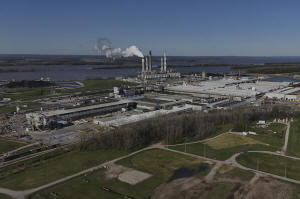Planet-warming emissions dropped when companies had to report them. EPA
wants to end that
[June 07, 2025]
By MELINA WALLING, SETH BORENSTEIN, JOSHUA A. BICKEL and M.K.
WILDEMAN
LEOPOLD, Ind. (AP) — On the ceiling of Abbie Brockman’s middle school
English classroom in Perry County, the fluorescent lights are covered
with images of a bright blue sky, a few clouds floating by.
Outside, the real sky isn’t always blue. Sometimes it’s hazy, with
pollution drifting from coal-fired power plants in this part of
southwest Indiana. Knowing exactly how much, and what it may be doing to
the people who live there, is why Brockman got involved with a local
environmental organization that’s installing air and water quality
monitors in her community.
“Industry and government is very, very, very powerful. It’s more
powerful than me. I’m just an English teacher,” Brockman said. But she
wants to feel she can make a difference.
In a way, Brockman’s monitoring echoes the reporting that the
Environmental Protection Agency began requiring from large polluters
more than a decade ago. Emissions from four coal-fired plants in
southwest Indiana have dropped 60% since 2010, when the rule took
effect.
That rule is now on the chopping block, one of many that President
Donald Trump’s EPA argues is costly and burdensome for industry.
But experts say dropping the requirement risks a big increase in
emissions if companies are no longer publicly accountable for what they
put in the air. And they say losing the data — at the same time the EPA
is cutting air quality monitoring elsewhere — would make it tougher to
fight climate change.

Rule required big polluters to say how much they are emitting
At stake is the Greenhouse Gas Reporting program, a 2009 rule from
President Barack Obama's administration that affects large carbon
polluters like refineries, power plants, wells and landfills. In the
years since, they've collectively reported a 20% drop in emissions,
mostly driven by the closure of coal plants.
And what happens at these big emitters makes a difference. Their
declining emissions account for more than three-quarters of the overall,
if modest, decline in all U.S. greenhouse gas emissions since 2010.
The registry includes places not usually thought of as big polluters but
that have notable greenhouse gas emissions, such as college campuses,
breweries and cereal factories. Even Walt Disney World in Florida, where
pollution dropped 62% since 2010, has to report along with nearly 10,600
other places.
"We can’t solve climate change without knowing how much pollution major
facilities are emitting and how that’s changing over time," said Jeremy
Symons, a former EPA senior climate adviser now at Environmental
Protection Network, an organization of ex-EPA officials that monitors
environmental policies. The group provided calculations as a part of The
Associated Press' analysis of impacts from proposed rule rollbacks.
Symons said some companies would welcome the end of the registry because
it would make it easier to pollute.
Experts see a role for registry in cutting emissions
It’s not clear how much the registry itself has contributed to declining
emissions. More targeted regulations on smokestack emissions, as well as
coal being crowded out by cheaper and less polluting natural gas, are
bigger factors.
But the registry “does put pressure on companies to ... document what
they’ve done or at least to provide a baseline for what they’ve done,”
said Stanford University climate scientist Rob Jackson, who heads Global
Carbon Project, a group of scientists that tally national carbon
emissions yearly.
[to top of second column]
|

The Warrick Power Plant operates Tuesday, April 8, 2025, in
Newburgh, Ind. (AP Photo/Joshua A. Bickel)
 Gina McCarthy, a former EPA
administrator under Obama, said the registry makes clear how power
plants are doing against each other, and that's an inducement to
lower emissions.
"It is money for those companies. It's costs. It's reputation. It's
been, I think, a wonderful success story and I hope it continues.”
The potential end of the reporting requirement comes as experts say
much of the country's air goes unmonitored. Nelson Arley Roque, a
Penn State professor who co-authored a study in April on these
“monitoring deserts,” said about 40% of U.S. lands are unmonitored.
That often includes poor and rural neighborhoods.
"The air matters to all of us, but apparently 50 million people
can’t know or will never know'' how bad the air is, Roque said.
EPA seeks to cancel money to fund some air monitoring
The EPA is also trying to claw back money that had been earmarked
for air monitoring, part of the termination of grants that it has
labeled as targeting diversity, equity and inclusion. That includes
$500,000 that would have funded 40 air monitors in a low-income and
minority community in the Charlotte, North Carolina, area.
CleaneAIRE NC, a nonprofit that works to improve air quality across
the state that was awarded the grant, is suing.
“It’s not diversity, equity and inclusion. It’s human rights,” said
Daisha Wall, the group's community science program manager. “We all
deserve a right to clean air.”
Research strongly links poor air quality to diseases like asthma and
heart disease, with a slightly less established link to cancer. Near
polluting industries, experts say what’s often lacking is either
enough data in specific locations or the will to investigate the
health toll.
Indiana says it “maintains a robust statewide monitoring and
assessment program for air, land and water,” but Brockman and others
in this part of the state aren't satisfied. She and other members of
local advocacy groups Southwestern Indiana Citizens for Quality of
Life and Valley Watch install and maintain their own air and water
quality monitors. It’s a full-time job to keep the network of
monitors up and running, fighting spotty Wi-Fi and connectivity
issues.
Fighting industry is a sensitive subject, Brockman added. Many
families depend on jobs at coal-fired power plants, and poverty is
real. She keeps snacks in her desk for the kids who haven’t eaten
breakfast.
“But you also don’t want to hear of another student that has a rare
cancer,” she said.
___
Associated Press writer Matthew Daly contributed from Washington.
All contents © copyright 2025 Associated Press. All rights reserved
 |